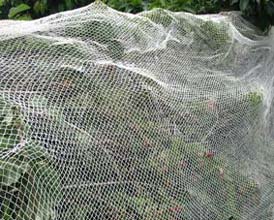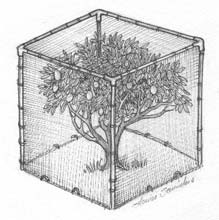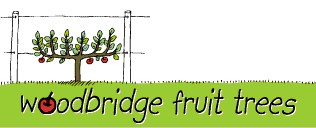No products
Planting and Caring for your Trees
When to Plant.
Plant your trees in July and August, or even as late as September when the tree has already begun shooting. If you're not immediately ready to plant you can "heel" in the young trees in a temporary position for a week or so by just digging a hole in any garden soil and completely covering the roots with damp earth. The worst thing that can happen to the tree is that the roots dry out, but don't sit it in water for to many days as it may rot.
Choosing a site.
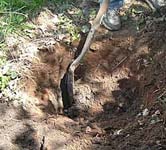 In these dry times, the site should have a good water supply especially during summer when the tree does most of it's growing. The position should ideally get a good amount of sun while being protected from the northerly and westerly winds. There is constant debate whether to plant East to West or from North to South in rows. For some there is no option, but take into account water drainage and erosion of soil, which is better up and down the slope. Keep out of the root zone of eucalyptus trees. Our dwarf fruit trees fit very happily into a back yard vegetable garden grown on fences.
In these dry times, the site should have a good water supply especially during summer when the tree does most of it's growing. The position should ideally get a good amount of sun while being protected from the northerly and westerly winds. There is constant debate whether to plant East to West or from North to South in rows. For some there is no option, but take into account water drainage and erosion of soil, which is better up and down the slope. Keep out of the root zone of eucalyptus trees. Our dwarf fruit trees fit very happily into a back yard vegetable garden grown on fences.
Preparing the Soil.
If you have the foresight to prepare planting positions 6 months in advance it will be well repaid in early tree growth and health. We recommend digging holes 30-40cm deep and wide and filling them with compost, mushroom compost, manures, organic matter, scraps, actually anything organic and letting it rot down for 6 months. Green manures that have been planted before can be dug in. When planting time arrives the worms and beneficial soil organisms have broken down this into a rich humus and created a perfect planting environment. These aid in mobilising nutrients and minerals for the tree. Some rock dust can aid in enriching the soil with minerals, or a soil test may reveal a specific deficiency.
When using a rotary hoe, ensure a hard pan isn’t created where water tends to run where soft and hard soil meet. Using a ripping tine on a tractor can break up the ground below this layer and allow excessive water to drain away.
Clay Soils.
Clay can be a great source of minerals that benefit fruit trees. However, clay soil tends to dry out during summer months, and the cracks that form when it shrinks allows any water to drain away quite quickly. The opposite is true during winter, when the clay gets water-logged and causes water to pool around the tree roots causing disease. Beware of digging a big hole, as it becomes a bucket that holds water - ensure that there is an adequate drainage trench leading away from the hole. Gypsum and dolomite lime can help break down the clay, and adding some coarse sand and lots of organic matter can assist in problems associated with clay. This needs to be repeated especially mulching. Often planting the tree on a raised mound can lift the roots a little away from being water-logged.
Setting up the espalier.
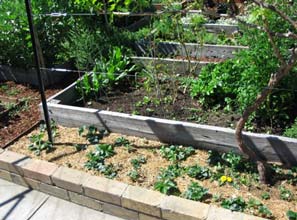
This makes it a lot easier if you get this done before planting the tree, as it gives you a guide on what angle to plant. Espaliers can be made from almost anything, but one of the easiest is to get some long metal posts (star-pickets) and simply connect some wire at the desired height. You can strain the wire with a simple tension system at each end of the espalier posts with a diagonal wire attached to a peg in the ground and twirled with a firm stick to get it tight. A post every 2-3 meters will support the wire better than a longer span. There are much more elegant systems that you can get from fencing supply shops, or make something more makeshift out of wooden posts and string. Another method is to nail / screw in some hooks into an existing wall, and tie wire between them - keeping them 10-15cm off the wall. A lattice can work too, or some makeshift bamboo tied together, although this wont last long!
Planting.
This is the easy bit compared to all the work on infrastructure. Place the roots into the hole that's been dug and fill the hole with soil. Make sure the roots are below the soil, but dont plant too deeply, keeping the graft above the ground. Firm the soil in a little, and water in well. Stake.
Pruning.
- It reduces the amount of vegetation needing to be supplied by the as-yet unestablished roots. The first and fore-most task of the tree after planting is to establish it's feeder roots. If that is not done, the tree will dry out and die. If you fruit tree or berry bush is multi-branched, prune it back to one or two leaders.
- It shapes the tree. Decide at what height you'd like the tree to start branching, and prune just above this point. A trunk 50-60cm from the ground will allow easy access to the base of the tree for mulching, weeding and removing suckers. A shorter trunk may prevent this. A higher trunk will mean branching occurs up higher, which may be desirable for some wanting more of an umbrella style shape. The disadvantage of a tall trunk is that the fruit are more likely to be inaccessable.
- If you are using an espalier, prune just above the first wire and attach to the wire to prevent the tree wacking the wire in the breeze.
Mulching.
Ideal to spread around the base of the tree to prevent weed growth, reduce water loss and provide decomposing organic matter as a source of food. However, there are some things to consider, as not all mulches are suitable. Gum barks and sawdust can leech nutrients away from the soil, starving the tree, and pine barks do the same plus make the soil beneath acidic. Some mulches can harbour disease eg. Hay can grow moulds and fungi, plus form a home for slugs and rodents. Best is composted organic matter and manures. Some stable manures contain antibiotics and anti-fungals that can persist even after composting and can kill worms and beneficial soil bacteria.
Weeding.
Grasses and field perennials are grow rapidly and set up to compete for nutrients and water. About a 30cm radius of ground around the base of the tree should be kept free of grasses and weeds so to give the tree as much chance of using the water and nutrients that you provide. Weeds can grow quickly, so check from time to time. Young grasses are easier to kill than larger ones with established root systems. When using a hoe to dig the weeds out, ensure you don't go too deep and disturb the tree roots. Freshly dug soil will tend to dry out easily so ensure a mulch covers the soil and keep the water up to the tree. Some people use sprays - be ware of getting things like glycophate on the tree's leaves (bark is OK), and be aware that after repeated applications, it can leech into the roots via the soil.
Watering System.
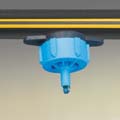 The most efficient and water saving systems use drippers. Run a line on the bottom wire rather than on the ground as it doesnt get caught up with weeding tools or mowers. The time the tree needs water is when it is dry - ie late spring to early autumn. Get a feel for the ground around the tree's stem to see if you are watering enough. Maintenance. Keep the grass away from growing around the trunk of the tree. Keep the area at the base mulched and weed free, particularly perennial grasses. Have a strategy ready to protect against pests, especially rabbits, and wallabies that just love to graze on new trees, with good fencing.
The most efficient and water saving systems use drippers. Run a line on the bottom wire rather than on the ground as it doesnt get caught up with weeding tools or mowers. The time the tree needs water is when it is dry - ie late spring to early autumn. Get a feel for the ground around the tree's stem to see if you are watering enough. Maintenance. Keep the grass away from growing around the trunk of the tree. Keep the area at the base mulched and weed free, particularly perennial grasses. Have a strategy ready to protect against pests, especially rabbits, and wallabies that just love to graze on new trees, with good fencing.
Managing Pests
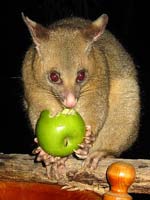 After all that work getting your orchard established, all it takes is one attack from possums, rabbits, birds or wallabies to damage your tree or eat the long anticipated fruit. It does happen to most people sooner or later, even in suburban areas, and it pays to do some work to prevent it. For individual trees, a simple net thrown over the tree during harvest may be enough, but sometimes there needs to be a wire barrier all over the orchard, especially near the bush. We have seen various methods work: galvanised iron at the base, then wire netting on top to make a cage. Others have use a "floppy top" fence, in conjunction with electric fencing to prevent possums and wallabies.
After all that work getting your orchard established, all it takes is one attack from possums, rabbits, birds or wallabies to damage your tree or eat the long anticipated fruit. It does happen to most people sooner or later, even in suburban areas, and it pays to do some work to prevent it. For individual trees, a simple net thrown over the tree during harvest may be enough, but sometimes there needs to be a wire barrier all over the orchard, especially near the bush. We have seen various methods work: galvanised iron at the base, then wire netting on top to make a cage. Others have use a "floppy top" fence, in conjunction with electric fencing to prevent possums and wallabies. 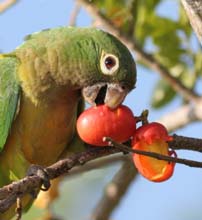
Rabbits can be a pest when ring barking young trees - a some mesh wrapped 40cm at the base can help but needs to be loosened off after a few years to prevent strangulation. We have had some success painting the bottom 40cm of young trees with bitumen paint. Unless made well, any structure has a weak spot, and often then the pest cannot get out again. Birds and possums can be quite smart - once they know something tasty is there, they often come back for a feast every so often. Weak points are corners and joins in wire or netting. Also overhanging branches or fences that are easily dug under can be the downfall of what seems an impenetrable system! Otherwise a dog that keeps them at bay can help too, - it would be sad for you to see your hard work and investment devoured by the wildlife.
